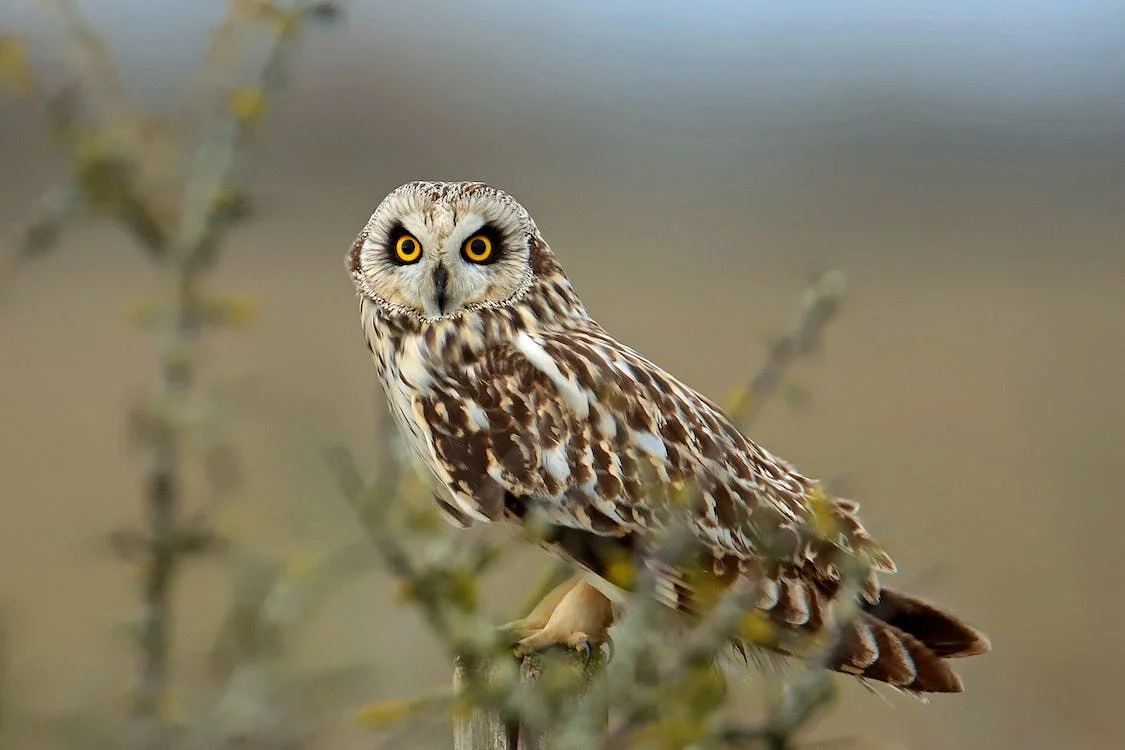It is a relatively large, brown owl, with distinct tiny ear tufts. While mainly nocturnal, it is sometimes seen active before dusk and after dawn. Prefers moist grasslands, marshes, and cultivated lands. It is known to store food items in enclosed spaces or “caches” for later consumption. Not vociferous and generally silent in flight, but may produce quiet rasping calls.
Read further to know more about the Marsh Owl.
What is a Marsh Owl?
Marsh Owl (Asio capensis) is a medium to large owl species belonging to the Strigidae family and the genus Asio, which includes “eared-owls.” Its range is spread throughout much of sub-Saharan Africa, and this bird thrives in grassland, marshlands, and cultivation. It is both ecologically and morphologically similar to the Short-Eared Owl – its closest cousin.
Its seven levels of classification are as follows:
Kingdom: Animalia
Phylum: Chordata
Class: Aves
Order: Strigiformes
Family: Strigidae
Genus: Asio
Species: A. capensis
Marsh Owl Physical Description
Marsh Owl is a medium to large owl, growing from 11.4 to 14.1 inches or 29 to 36 centimeters, weighing 225 to 375 grams, with a wingspan of 32.2 to 38.9 inches or 82 to 99 centimeters.
This bird has a plain body and wing tetrices. On the upperwings, the outer primary feathers are buff-streaked, while secondary feathers are darkish with light-brownish edges. A whitish terminal stripe and buff bars occur on the dark brown and white-barred tail. Underparts are also barred with a dark brownish tone while underwing displays a black carpal patch.
Marsh Owl’s head is characterized by a light brownish-yellow facial disk, which shows a dark circle around the dark brown eyes. Its short, distinct ear-tufts stand out. Meanwhile, its bill is grayish with a black tip. The tarsi are covered with dull buff feathers, while toes are tucked by subtle buffy to whitish feathering. The talons are darkish.
Both sexes look similar, but females are relatively darker and larger than males. Juveniles or immature birds sport a darker facial disk, circled in black.
Where can they be spotted?
Marsh Owls prefer grasslands, marshlands, cultivated areas, with short vegetation and ample patches of tall grass, weeds, or reeds. They can also occur in mangroves, open savannas, drainage strips, and sometimes in open areas near human settlements. These birds avoid rocky landscapes, extensive long grass, and forested regions. While mainly residents, they are partly nomadic within their sub-Saharan African range.
Interesting Facts You Should Know About the Marsh Owl
Marsh Owl’s diet revolves primarily on insects such as beetles, termites, grasshoppers, and scorpions, and various invertebrates and vertebrates, like birds, lizards, frogs, mice, shrews, bats, and young hares. It hunts mostly in flight, flying low over the ground with slow but powerful wingbeats, keenly watching for its victims, hovering, and shifting direction if needed.
Once it spots any prey, it will dive and snatch it using its talons. This bird is an incredible hunter due to their acute eyesight. It is nocturnal but may hunt before dusk and after dawn. Food items are often kept in caches or concealed areas for later consumption.
Their breeding season varies depending on the range but usually takes place from September to November in southwestern Africa. At the start of the breeding period, the male marsh owl performs flight displays during dusk to affirm his territory. It soars high, accompanied by hard wingbeats and wing clapping motion below its body.
Marsh Owls are monogamous and territorial birds and will defend their territory from intruders. They build the nest on a shallow scrape on the ground, lined with dry leaves, hidden among weeds and grasses. The female will lay a clutch of 2-4 eggs, which she will incubate solely for about 27 to 28 days while the male hunts for their food. After hatching, the chicks will remain for about 18 days before crawling around the nest. Soon enough, the broods will fledge about 35 days after hatching. They will be covered in full feathers as they reach 70 days of age and become independent after another 30 days.
While their habitat and nests are often destroyed by fire and flooding or trampled by grazers and predators, Marsh Owls are not globally threatened. They are currently evaluated as Least Concern (LC) under the IUCN Red List of Threatened Species.
WILDLIFE PARKS AND RESERVES WHERE THIS SPECIES IS FOUND:
BOTSWANA
SOUTH AFRICA
NAMIBIA
ZAMBIA
ZIMBABWE
BOTSWANA BIRDS | SOUTH AFRICA BIRDS
NAMIBIA BIRDS | ZAMBIA BIRDS | ZIMBABWE BIRDS
